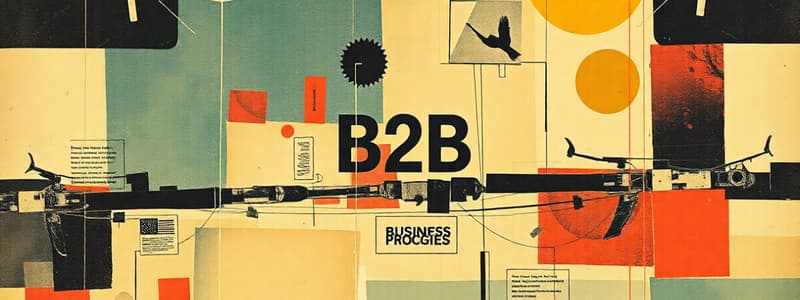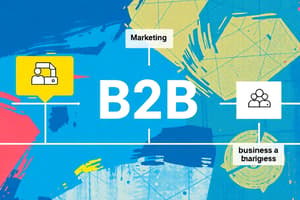Podcast
Questions and Answers
What is the purpose of the Request For Proposal (RFP) process?
What is the purpose of the Request For Proposal (RFP) process?
Which of the following is a consideration in the proposal analysis and supplier selection stage?
Which of the following is a consideration in the proposal analysis and supplier selection stage?
What does the vendor performance assessment typically involve?
What does the vendor performance assessment typically involve?
Which stage involves placing firm orders with all terms detailed?
Which stage involves placing firm orders with all terms detailed?
Signup and view all the answers
How does organizational culture affect purchasing decisions in B2B markets?
How does organizational culture affect purchasing decisions in B2B markets?
Signup and view all the answers
What aspect is typically not a focus during the product specification stage?
What aspect is typically not a focus during the product specification stage?
Signup and view all the answers
Which factor could be seen as a procurement challenge for businesses?
Which factor could be seen as a procurement challenge for businesses?
Signup and view all the answers
What does the 'Buying Centre' concept encompass?
What does the 'Buying Centre' concept encompass?
Signup and view all the answers
Which of the following methods can enhance B2B relationships?
Which of the following methods can enhance B2B relationships?
Signup and view all the answers
In what situation is a buying center likely to use all six steps in the buying process?
In what situation is a buying center likely to use all six steps in the buying process?
Signup and view all the answers
What advantage do current vendors typically have in B2B purchasing?
What advantage do current vendors typically have in B2B purchasing?
Signup and view all the answers
Which of the following statements describes purchasing additional units of previously acquired products?
Which of the following statements describes purchasing additional units of previously acquired products?
Signup and view all the answers
What is one characteristic of the B2C market compared to B2B?
What is one characteristic of the B2C market compared to B2B?
Signup and view all the answers
What role do social media micro-influencers play in enhancing B2B relationships?
What role do social media micro-influencers play in enhancing B2B relationships?
Signup and view all the answers
What is one of the procurement challenges faced by businesses in a B2B context?
What is one of the procurement challenges faced by businesses in a B2B context?
Signup and view all the answers
How is the process of purchasing products in B2B most commonly characterized?
How is the process of purchasing products in B2B most commonly characterized?
Signup and view all the answers
What is one of the key challenges in reaching B2B clients?
What is one of the key challenges in reaching B2B clients?
Signup and view all the answers
In B2B markets, demand tends to be more inelastic due to which reason?
In B2B markets, demand tends to be more inelastic due to which reason?
Signup and view all the answers
What is a primary feature of products in B2B transactions?
What is a primary feature of products in B2B transactions?
Signup and view all the answers
Which characteristic differentiates the buying process of B2B from B2C?
Which characteristic differentiates the buying process of B2B from B2C?
Signup and view all the answers
What is a common procurement challenge for businesses in B2B markets?
What is a common procurement challenge for businesses in B2B markets?
Signup and view all the answers
Which factor is crucial for B2B purchasing decisions?
Which factor is crucial for B2B purchasing decisions?
Signup and view all the answers
How does the marketing mix differ in B2B compared to B2C?
How does the marketing mix differ in B2B compared to B2C?
Signup and view all the answers
What represents demand characteristics specific to B2B markets?
What represents demand characteristics specific to B2B markets?
Signup and view all the answers
Which stage in the B2B buying process involves recognizing the need to purchase?
Which stage in the B2B buying process involves recognizing the need to purchase?
Signup and view all the answers
What is typically a primary motivation for B2B purchases?
What is typically a primary motivation for B2B purchases?
Signup and view all the answers
Flashcards
B2B relationship building
B2B relationship building
Methods to improve business-to-business relationships, often involving social media and other digital tools.
Social Media's role in B2B
Social Media's role in B2B
Social media tools like blogs and social media can raise awareness, give clients detailed information about products, and improve B2B relationships.
Micro-Influencers in B2B
Micro-Influencers in B2B
Micro-influencers can review products on social media channels, helping to promote products or services in B2B marketing.
First-time purchase
First-time purchase
Signup and view all the flashcards
Additional purchase
Additional purchase
Signup and view all the flashcards
Buying situation types
Buying situation types
Signup and view all the flashcards
Buying Process Steps
Buying Process Steps
Signup and view all the flashcards
Vendor Advantage
Vendor Advantage
Signup and view all the flashcards
Product Specification
Product Specification
Signup and view all the flashcards
Request for Proposal (RFP)
Request for Proposal (RFP)
Signup and view all the flashcards
What are key considerations beyond price in supplier selection?
What are key considerations beyond price in supplier selection?
Signup and view all the flashcards
Order Specification (Purchase)
Order Specification (Purchase)
Signup and view all the flashcards
Vendor Performance Assessment
Vendor Performance Assessment
Signup and view all the flashcards
Buying Centre
Buying Centre
Signup and view all the flashcards
Organizational Culture
Organizational Culture
Signup and view all the flashcards
How does organizational culture impact buying decisions?
How does organizational culture impact buying decisions?
Signup and view all the flashcards
B2B vs. B2C Market Differences
B2B vs. B2C Market Differences
Signup and view all the flashcards
B2B Demand
B2B Demand
Signup and view all the flashcards
B2B Product Characteristics
B2B Product Characteristics
Signup and view all the flashcards
B2B Buying Process
B2B Buying Process
Signup and view all the flashcards
B2B Marketing Mix
B2B Marketing Mix
Signup and view all the flashcards
Need Recognition (B2B)
Need Recognition (B2B)
Signup and view all the flashcards
Decision Makers in B2B
Decision Makers in B2B
Signup and view all the flashcards
B2B Buying Process Steps
B2B Buying Process Steps
Signup and view all the flashcards
Buying Process Understanding
Buying Process Understanding
Signup and view all the flashcards
Influencing Factors (B2B)
Influencing Factors (B2B)
Signup and view all the flashcards
Study Notes
Chapter 5: Business-to-Business Marketing
- This chapter covers Business-to-Business (B2B) marketing.
- Learning Objectives:
- Describe the nature and composition of B2B markets.
- Explain the key differences between B2B and B2C buying.
- List the steps in the B2B buying process.
- Identify the roles within the buying center.
- Detail different buying situations.
Business-to-Business Marketing
- Mastercard Track Business Payment Service streamlines payment and data transfer between firms.
- B2B marketing involves buying and selling goods/services used in production, consumption by the buying firm, or resale by wholesalers/retailers.
- Distinguishing factor in B2B vs. B2C is the ultimate purchaser and user of the product or service.
B2B Markets
- B2B firms target specific customer markets to create value.
- Examples include Shopify (online presence) and Apple/Google (integrating their operating systems into cars).
- B2B markets include manufacturers, resellers, institutions, and government.
Manufacturers or Producers
- These firms buy raw materials, components, or parts.
- They also manufacture their own goods (e.g., Skoda, Audi, Volkswagen, etc.).
Resellers
- Resellers include manufacturers, resellers and retailers.
Institutions
- Institutions include schools, museums, and religious organizations.
Government
- The Canadian government spends $240B annually on goods and services.
- Provincial and local governments also make significant purchases.
- Firms specialize in selling to the government.
Key Challenges of Reaching B2B Clients
- Identifying decision-makers in an organization who authorize or influence purchases.
- Understanding the buying process of potential clients.
- Identifying factors influencing the buying process of potential clients.
Differences Between B2B & B2C Markets
- Market Characteristics: B2B demand is often derived, with fewer, geographically concentrated customers and larger orders. Demand is generally more inelastic. B2C markets typically have more diffuse customer bases and are less geographically concentrated.
- Product Characteristics: B2B products are often technical, based on specifications, and frequently raw or semi-finished goods. B2C goods tend to be more consumer-focused and readily usable by the final user. B2B purchasers often place a greater emphasis on delivery time, technical assistance, and post-sale service.
- Buying Process Characteristics: B2B buying decisions are often more complex, involving competitive bidding, negotiated pricing, extensive financial arrangements, and multiple participants. Qualified, professional buyers participate in a more formalized process to establish more objective criteria.
- Marketing Mix Characteristics: B2B marketing often involves direct selling, physical distribution is more crucial, and advertising tends to be more technical and personal, focusing on building strong relationships. Price often depends on vendor relationships/quantity discounts, and is less of a focus for B2C consumers.
The B2B Buying Process
- Need Recognition: Needs can originate internally or externally (from suppliers, salespeople, or competitors). The example provided details the need for school tablets.
- Product Specification: Suppliers develop proposals, and collaboration with suppliers is often possible.
- RFP Process: Buying organizations solicit bids from alternative suppliers for required components or specifications.
- Proposal Analysis & Supplier Selection: Multiple vendors usually negotiate, and factors other than price influence selection.
- Order Specification (Purchase): Order placement, with exact details specified and payment terms detailed.
- Vendor Performance Assessment Using Metrics: Evaluates vendor performance using a numeric and weighted scoring system.
The Buying Centre
- The buying centre consists of various roles involved in the purchasing process. Key roles are identified as Initiator, Influencer, Decider, Gatekeeper, Buyer, and User.
Organizational Culture
- Organizational culture includes values, traditions, and customs influencing managers' and employees' behaviors.
- There are also different types of buying cultures: Autocratic, Consultative, Democratic, Consensus.
Building B2B Relationships
- A variety of methods is used to strengthen relationships, including blogs and social media.
- These can increase awareness and educate potential clients about products and services.
Buying Situations
- New Buy: Purchasing for the first time (often more involved).
- Straight Rebuy: Repurchasing the same product under similar specifications.
- Modified Rebuy: Repurchasing a similar product, but with changed specifications. Most B2B purchases fall into these categories.
Studying That Suits You
Use AI to generate personalized quizzes and flashcards to suit your learning preferences.
Related Documents
Description
Explore the intricacies of Business-to-Business (B2B) marketing in Chapter 5. This chapter provides insights into B2B market composition, differences from B2C buying, the B2B buying process, and roles within the buying center. Enhance your understanding of the essential components that drive B2B marketing strategies.




